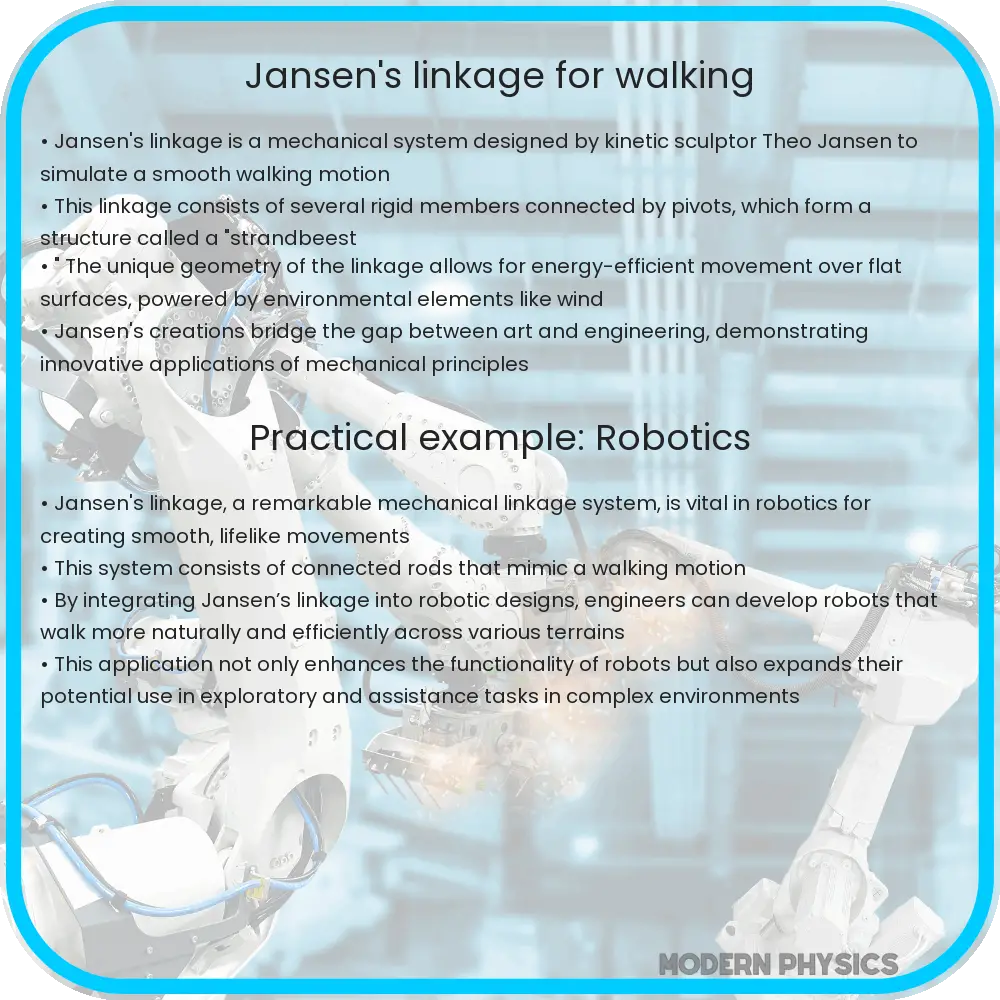Explore Jansen’s Linkage: a revolutionary kinematic design in robotics, mimicking natural movement with remarkable efficiency and aesthetics.

Understanding Jansen’s Linkage: A Marvel in Kinematic Design
Theo Jansen’s Strandbeest, an awe-inspiring blend of art and engineering, operates on the fundamental principles of Jansen’s Linkage. This intricate mechanism, a paragon of kinematic design, simulates the gait of walking creatures. Its unique configuration of pivoting segments creates a fluid, life-like movement, marking a significant advancement in both robotics and mechanical design.
Essentials of Jansen’s Linkage
At the heart of Jansen’s Linkage lies its unique assembly of rods and pivots. These elements are meticulously arranged to mimic biological leg movements. The efficiency of this system is evident in the smooth, wave-like motion of each ‘leg,’ achieved through the harmonious coordination of its components.
- Construction: The linkage consists of several bars connected by pivots, creating a complex yet efficient locomotion mechanism.
- Motion Principle: The system transforms rotary motion into a walking pattern, closely resembling the natural gait of animals.
- Materials: Lightweight yet sturdy materials are employed, enhancing the linkage’s efficiency and functionality.
Efficiency in Kinematics
Jansen’s Linkage stands out for its extraordinary efficiency. This efficiency is not merely in energy consumption but also in the replication of organic movement with minimal mechanical complexity. The linkage uses the least amount of energy to produce maximum movement, a principle crucial in robotics and mechanical design.
- Energy Optimization: The design minimizes wasted motion, translating most of the input energy into movement.
- Biomechanical Simulation: It closely replicates the natural efficiency found in the movement of living organisms.
Implications for Robotics
Jansen’s Linkage has profound implications for robotics. Its ability to imitate life-like movement using simple mechanical elements makes it an invaluable model for designing efficient, biomimetic robots. This has opened new avenues in robotic design, focusing on creating machines that move more fluidly and interact more harmoniously with their environment.
By studying and applying the principles of Jansen’s Linkage, engineers and designers can develop robots that not only move efficiently but also exhibit a degree of naturalism previously unattainable in mechanical constructs. This integration of art, biology, and engineering paves the way for innovative advancements in robotics, where efficiency and aesthetic appeal coexist seamlessly.
Integration in Modern Robotics and Beyond
The principles of Jansen’s Linkage are increasingly integrated into modern robotics, particularly in areas requiring efficient and lifelike movement. This includes applications in search and rescue operations, where robots must navigate complex terrains, and in entertainment, where robotic creatures offer a new level of realism.
- Search and Rescue Robots: The linkage’s ability to traverse uneven surfaces with ease makes it ideal for robots designed to operate in challenging environments.
- Entertainment and Art Installations: The aesthetic appeal and fluidity of motion of Jansen’s Linkage have found a place in artistic expressions and entertainment robotics, mesmerizing audiences with its lifelike movements.
Challenges and Future Prospects
While Jansen’s Linkage offers remarkable advantages, it’s not without its challenges. The complexity of its design can lead to maintenance and durability issues. However, ongoing research and technological advancements continue to refine and address these challenges, pushing the boundaries of what’s possible in kinetic art and robotics.
- Maintenance: Regular upkeep is required to ensure the smooth functioning of the linkage, given its intricate structure.
- Durability: The linkage’s components may be subject to wear and tear, particularly in harsh operational environments.
- Innovation: Continuous innovation is driving improvements in materials and design, enhancing the durability and efficiency of the linkage.
Conclusion: The Legacy of Jansen’s Linkage
Jansen’s Linkage represents a brilliant intersection of art, biology, and engineering. Its ability to replicate natural movement with mechanical simplicity has not only revolutionized kinetic art but also holds immense potential for the future of robotics. The efficiency, aesthetic appeal, and biomimetic qualities of this linkage provide a robust foundation for innovative developments in various fields.
As technology evolves, the applications of Jansen’s Linkage are bound to expand, offering new solutions to complex problems and enriching the world of robotics and beyond. Its legacy continues as a testament to the power of creative engineering, demonstrating how the synthesis of different disciplines can lead to groundbreaking inventions and advancements.
